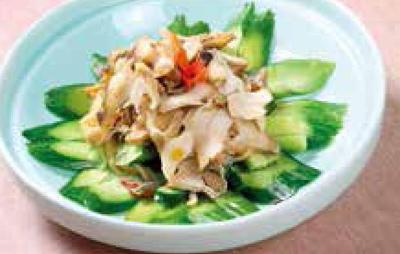辣螺,海中的辣妹子
陈汉莉



在浙南一带,食客们往往喜欢将水煮的辣螺蘸点酱醋搭配着食用,苦、辣、酸、甘,也只有辣螺这样的“辣妹子”,才能把这样刺激的味道掺和在一起却毫无违和感,就如把人生的况味都融到一口螺的内容里,让人感觉奇妙无穷。
辣螺,螺如其名,单从名字上就可以猜出這是一种有辣味的螺。这种又苦又辣的螺,在沿海一带极为常见,其貌不扬,其价不高。有人大赞好吃,有人绝口不吃,还有人说,这种螺吃到最后味道更好感觉更妙。
唐宋时的小海鲜爆款
浙江一带所说的“辣螺”,又称口水螺,学名为“疣荔枝螺”,属骨螺科,外壳呈疣状突起如荔枝表面,故名。这种生长在海滩岩石缝隙里的小螺,第一眼看见,真的不会爱上——壳厚,色绿,外壳疙疙瘩瘩,样子既粗糙又丑陋,实在不招人喜欢。
辣螺之所以得名,是因为它尾端自带辣味,这种以辣得“浑然天成”而著称的小海螺,早在古代就备受食客青睐。宋韩淲在诗中说:“螺之辣者真海鲜,每或酌侑能醒然。”宋人罗大经在《鹤林玉露》中将“螺头新妇臂,龟脚老婆牙”这四种小海鲜列为浙江沿海一带推崇的特产,据说连宋孝宗亦为之赞。其中,“螺头”位居第一,这里的“螺头”尤指辣螺,以肉鲜微辣有清香而著称,早在唐宋时期就已成珍奇海鲜,传于宫廷内外。
辣螺,明弘治时的《温州府志》、明代屠本畯的《闽中海错疏》中均称之为“蓼螺”。《诗经·周颂》中说“其馕伊黍,其笠伊纠。其镈斯赵,以薅荼蓼”。蓼,为一年生草本植物,生长在水边或水中,其茎叶味辛辣,可用以调味。清代陈昌治刻本《说文解字》谓“蓼”为:“辛菜”。“蓼”,可以说就是“辣”的代名词。因此,宋《证类本草》中解释:辣螺,“生永嘉海中,味辛辣如蓼,故名蓼螺。”民国《平阳县志》则称之为“辛螺”,曰:“俗名辣螺,形小如螺蛳,肉美带辣。”单一句话,就概括了这种螺的外形与味道。辣螺煮熟后,有点辣,还有点苦,福建厦门等地也称之为“苦螺”。
农历三月初三捡辣螺
在赶海人的眼中,辣螺是最常见的,属于比较容易捕获的小海鲜。人们通常说“敲雀嘴”“凿龟足”“捡辣螺”,听起来,捕获辣螺似乎不需什么技术,似乎只要伸手去捡就可以了,毫无难度。其实,捡辣螺虽然不需要高难度的技术,也不存在太大的风险,但捡也是有讲究的,只有深知潮汐习性的渔夫渔嫂们,才更了解如何捡到又大又好的辣螺的独门诀窍。
在浙闽沿海一带,有渔谚云“三月三,辣螺爬满滩。”每年农历三月三前后,随着大地转暖气温开始升高,浅海处辣螺会争相爬上滩头岩礁间繁殖,渔村里的妇女孩子们就会趁着这个时候去海边捡拾辣螺,如同旧时农耕收获季节拾麦穗拾稻穗一般。这习俗据传与一个民间传说有关:旧时一渔家姑娘为追求忠贞不渝的爱情,因渔霸的胁逼于农历三月初三毅然投海,以死抗争。之后每逢三月三,海边辣螺旺发,爬满海滩,是因为渔家姑娘不忘生前盟誓,等候情人归来践约。这个传说,似乎极符合“辣螺姑娘”的气质。
辣螺在全国沿海均有分布,其形体上也有小有大,小的跟河里头的螺蛳差不多,大的则有成年人的拇指大小。在温州沿海一带,以洞头与苍南出产的辣螺为好。虽然各地出产的辣螺看起来都差不多,表壳黑灰色,全都清一色疙疙瘩瘩地长满“荔枝疣”,但仔细一看,苍南的略显淡绿,洞头的近乎淡棕色,倘若你再一路北上来到舟山,点上一盘最爱的辣螺,嘿,原来黑黑的“辣螺姑娘”此时的“肤色”竟然都变白了。这种色彩上的变化,许是由地域、环境及水温差异等的缘故造成的。因为有了不同的肤色,这些深受食客喜爱的“辣妹子们”就被贴上了不同地域的标签,“辣”出了各自不同的风味与特色。
辣螺喜集群生活。退潮后,喜欢在海滩上逐浪奔波的孩子们,老远地就能发现这些螺的外壳在阳光下泛着一种绿色的光,于是,他们向着那一片绿色奔去,每次总能收到潮水留下的馈赠。然而,人们往往发现,留在礁石表面上的一般只是个头很小的小辣螺,那些个头大的、上了年纪的辣螺,俨然已领悟了自然界适者生存的道理,它们躲藏在水下的礁石缝里。要对付这些老辣的家伙,就需要用上镊子等工具了。
苦辣蕴藏人生况味
捡了一篮子的辣螺回家,冲刷洗净,就可下锅了。对于辣螺这种自身味道就很有层次感的海味,美食家们尤其推荐以白水煮熟。
但对这种小海螺,北方或内地的人吃一个就绝不会再吃第二个,一致认为这种螺又苦又辣,实在吃不惯。究其原因,在螺肉一侧有一条黑绿色的螺线,辣味苦味蕴藏其中。沿海一带的人们则认为,这种螺直接用清水煮熟就非常鲜美,不仅肉质细腻,吃到嘴里的就是原汁原味,辣到本色,其精髓就是苦中有甘。
水煮辣螺做法比较简单,辣螺洗净,入锅加清水、姜片、料酒,煮个3分钟即可,按自己口味调好酱油、醋。
辣螺螺肉鲜嫩多汁,带着鲜甜味,有嚼劲,吃到最后,一丝辣味和一点苦味一起交汇。这种天生自带的苦辣,在舌尖上一沾,味蕾的感觉就来了——你看它:浑身长着尖刺一般,味道也极富刺激性,也只有真正的食客才懂得,这种刺痛般的辣味是这道海味真正灵魂所在。还有资深美食家说辣螺最好吃的是螺尾端,也就是螺屁股。
旧时,渔民捡到辣螺数量较多时,就将辣螺腌制起来,制成螺酱存放。腌制时要用锤子先把螺壳敲碎,敲出螺肉来后用盐腌渍一两天,沥去汤汁,再加入黄酒和少许食盐搅拌均匀,在密封容器内放置10天左右。出缸后,螺肉爽口、脆韧,而辣味回甘,余味悠长。
这种纯手工的腌制方法,全凭经验和感觉。其做法、配方历史悠久,都是一代代人口耳相传下来的,有着时间的味道。
千百年来,螺酱赢得食客们的青睐。宋代大文豪苏轼在《杭州故人信至齐安》中写道:“轻圆白晒荔,脆酽红螺酱。更将西庵茶,劝我洗江瘴。”在这里,东坡先生甚至将螺酱与当时“一骑红尘妃子笑”的荔枝相提并论,可见这海岛珍馐之美味,以及其历史之悠长。
在浙南一带,食客们往往喜欢将水煮的辣螺蘸点酱、醋搭配着食用,苦、辣、酸、甘,也只有辣螺这样的“辣妹子”,才能把这样刺激的味道掺和在一起却毫无违和感,就如,把人生的况味都融到一口螺的内容里,让人感觉奇妙无穷。
在中医看来,辣螺是一种性寒的食物,所以在煮的时候可以搭配放一些生姜,不但除土腥味,还可以驱寒,或者在调制辣螺的蘸酱时放点姜醋。喜欢口味重的,则要把螺壳敲碎,连壳带肉一起爆炒,加姜、蒜、辣椒酱、醋翻炒出锅,香辣咸香,下酒最好。等到螺肉被大快朵颐一扫而空,一盤碎螺壳依然沉醉在浓郁的汤汁之中。这种烧法让浓郁的香辣掩盖了淡淡的苦,也掩盖了淡淡的甘甜。
对于辣螺,最够味的吃法是在浙江沿海一带。在夏日夜晚的大排档上,一张餐桌边,围坐着两三个至交好友,桌上是冰鲜的扎啤,玻璃杯里泡沫冒着,兀地端上来一大盘香辣爆炒辣螺,于是,啤酒清清淡淡的苦和着螺肉浓浓淡淡的辣,在舌尖上掺杂着,就此把一个晚上的时光狠狠消磨掉。
这个场景,真正应了宋代张九成在《闻彦执熙仲有辣螺诗聊复有作》中所说的:“入口小辛美且清,荐酒百盏壶更倾。”
似乎因了辣螺,千百年的时光也不过就是推杯换盏、觥筹交错的那一瞬。
(本文图片来自视觉中国)
Spicy Whelk:Hot Delicacy from Sea
By Chen Hanli
For people living in the coastal areas of southern Zhejiang Province, the nondescript spicy taste of (Thais clavigera Kuster, or spicy whelk) resembles just the taste of life. Homey and commonplace, this delicacy bestowed by the ocean is a delight for all the senses.
, as the name in Chinese suggests, has a spicy taste. This ordinary-looking sea snail is easy to catch, thusly commonplace on the seafood menu of people living in the coastal areas in Zhejiang Province. Its quaintly bittersweet and spicy taste is loved by some, and shunned by others. For its hard-core fans, the nondescript flavor leaves a lasting, pleasant aftertaste that is second to none. One mans meat is anothers poison.
The delicacy has quite a few nicknames in Zhejiang. One of them takes from its bumpy-looking shell that looks like that of litchi. This little sea creature, thriving in rock crevices on the beach, is by no means a joy to behold. However, its strangely spicy taste that comes from its tail end, appealed to seasoned foodies in as early as the Tang (618-907) times, or even earlier. The Song Dynasty (960-1279) food critic Luo Dajing ranked this ugly-looking sea snail species among the top four seafood specialties from the coastal areas of Zhejiang. Legend also has it that Emperor Xiaozong of the Song Dynasty was a big fan of .
The “pungency” that tastes indescribably good is perceived as “bitter” by people living in Xiamen and nearby areas in Fujian Province. In fact, a literary explanation of such “bitterness” dates back to the times of , Chinas very first collection of poems that date back to 1,100-600BC, edited by Confucius more than 2,500 years ago.
Zhejiang Provinces Wenzhou and Zhoushan Archipelago are considered by gourmets as the best places to enjoy first-class . The sea snails from the exposed shores of Dongtou and Cangnan are greenish and brownish in color, whilst the coasts of Zhoushan produce a whitish color. The smaller ones are easy to find when exposed on the reefs whenever tides recede. Bigger ones are survivors, hiding away in the depths of cracks underwater. Size, however, does not matter. The spiciness does.
In the old times when the seafaring people had to make each penny go a long way, snails collected from rocky beaches served as a primary source of dietary supply. The tradition of taking the meat out for salt curing is still practiced today. Seasoned with a little rice wine and processed for about 10 days in a sealed container, the meat tastes crisp and refreshingly spicy. The flavor crafted purely by time was mentioned by Su Dongpo in one of his poems, in which he compared the daintiness with the countrys best litchi.
The cooking method of varies depending on individual preference, but one cant go wrong with simple seasonings such as ginger slices and vinegar. Those preferring spicier and stronger flavors can try cracking the shell and stir-frying the whole thing with ginger, garlic, rice wine, and soy sauce.
The simplest way is enough to ensure the most authentic flavor of this inexpensive delicacy from the ocean. “Keep it simple and natural” and “minimalism” in the use of seasonings is the key to authenticity. Put rinsed snails into boiling water, throw in ginger slices and a teaspoonful of rice wine, and scoop the snails out after about three minutes. In the eye of the pickiest gourmets, the thrill brought by the queer spiciness is the taste of the soul of the ocean and the joy brought only by the finest bestowment from the nature.
For people living in the coastal areas in Zhejiang, is a must-have for the indulgence of beer-and-seafood nightlife at one of seaside food booths. The combination of the bitterness of beer and the spiciness of the snails feels just like the bittersweet of life.
Wined and dined to satiety, the neo-Confucian scholar Zhang Jiucheng of the Song Dynasty spoke of the “high-class” taste of the delicacy in glowing terms in one of his poems.

